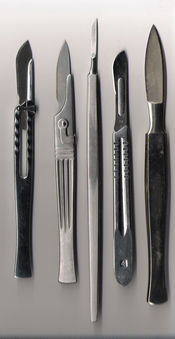Scalpel

Various scalpels. The first (from left), second, and fourth have replaceable blades
|
|
| Classification | Cutting tool |
|---|---|
| Used with | Stencil, Surgery |
| Related | Lancet, utility knife, laser scalpel |
A scalpel, or lancet, is a small and extremely sharp bladed instrument used for surgery, anatomical dissection, and various arts and crafts (called a hobby knife). Scalpels may be single-use disposable or re-usable. Re-usable scalpels can have permanently attached blades that can be sharpened or, more commonly, removable single-use blades. Disposable scalpels usually have a plastic handle with an extensible blade (like a utility knife) and are used once, then the entire instrument is discarded. Scalpel blades are usually individually packed in sterile pouches but are also offered non-sterile. Double-edged scalpels are referred to as "lancets".
Scalpel blades are usually made of hardened and tempered steel, stainless steel, or high carbon steel; in addition, titanium, ceramic, diamond and even obsidian knives are not uncommon. For example, when performing surgery under MRI guidance, steel blades are unusable (the blades would be drawn to the magnets, or may cause image artifacts). Historically, the preferred material for surgical scalpels was silver, on account of its antimicrobial properties (although the mechanics were not understood at the time). Scalpel blades are also offered by select manufacturers with a zirconium nitride-coated edge to improve sharpness and edge retention. Others manufacture blades that are polymer coated to enhance lubricity during a cut. Alternatives to scalpels in surgical applications include electrocautery and lasers.
Surgical scalpels consist of two parts, a blade and a handle. The handles are often reusable, with the blades being replaceable. In medical applications, each blade is only used once (even if just for a single, small cut).
The handle is also known as a "B.P. handle", named after Charles Russell Bard and Morgan Parker, founders of the Bard-Parker Company. Morgan Parker patented the 2-piece scalpel design in 1915 and Bard-Parker developed a method of cold sterilization that would not dull the blades, as did the heat-based method that was previously used.
...
Wikipedia
